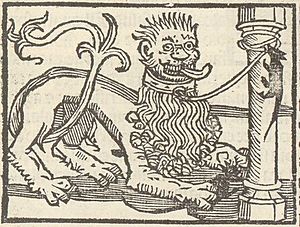The Lion and the Mouse facts for kids
The Lion and the Mouse is a famous story from Aesop's Fables. It's about a big, strong lion and a tiny mouse. This fable teaches us that even the smallest person can help someone much bigger or more important. Similar stories exist in other cultures, all showing how different creatures can depend on each other, no matter their size or power.
Contents
The Story of the Lion and the Mouse
The original story usually starts with a lion sleeping peacefully. A small mouse accidentally wakes the lion. The lion gets angry and threatens to eat the mouse. The mouse begs for its life, explaining that eating such a tiny creature would not make the lion look brave. The mouse also promises to help the lion someday, which makes the lion laugh. The lion then lets the mouse go.
Later, the lion gets caught in a strong net set by hunters. The lion roars loudly, trying to get free. The mouse hears the roars and remembers the lion's kindness. The mouse then uses its sharp teeth to chew through the ropes of the net, freeing the lion.
Lessons from the Fable
The main lesson of this story is that being kind to others can bring good rewards. It also shows that even someone small or seemingly unimportant can be a great help to someone much bigger or more powerful.
Different Versions of the Fable
Many writers have told this fable in their own ways over the centuries.
- The Scottish poet Robert Henryson wrote a long version in the 1480s. He added ideas about law, justice, and politics to the mouse's speech.
- In 1687, the poet Aphra Behn wrote about the fable. She said that even small acts of service are valuable. She compared the mouse helping the lion to how an oak tree once helped King Charles II hide from his enemies.
- The French poet Clément Marot wrote a version in 1534. He used the story to ask his friend for help when he was in prison. He called himself a "lowly rat" to match the mouse in the story.
- A famous French writer, La Fontaine, wrote a shorter, well-known version in the 1600s.
- The Russian writer Ivan Krylov wrote his version in 1833. In his story, the mouse asks to live on the lion's land, promising to be useful. The proud lion refuses. Only when the lion is trapped does he realize his pride was a mistake.
The Fable in Popular Culture
The story of the Lion and the Mouse has appeared in many places beyond books.
- It has been shown on household items like plates and tiles.
- In 1990, it was featured on a stamp in Zambia.
Political Cartoons and Media
Artists have used the fable to comment on political events:
- In 1844, a British cartoonist named John Doyle drew a cartoon where Earl Russell (the mouse) helped free Daniel O'Connell (the lion) from prison. O'Connell was a politician who wanted to change laws for Ireland.
- In the United States, a cartoon in 1913 used the fable to talk about lobbying (when people try to influence politicians). It showed a "rat" helping to free the government from "Lobbyism."
Animated Stories and Books
The fable has also been made into cartoons and children's books:
- In 1953, a short animated cartoon of the fable was made.
- The National Film Board of Canada made two versions:
* The Bear and the Mouse (1966) used real animals. * The Lion and the Mouse (1976) was an animated short film.
- Jerry Pinkney created a children's book called The Lion & the Mouse (2009). It tells the story only through pictures, without words, and won an award for its beautiful illustrations. This version is set in the Serengeti National Park.
A Different Ending: The Anti-Fable
Not all versions of the story have the same happy ending or moral.
- A writer named Laurentius Abstemius wrote a different version in 1499. In his story, the lion offers the mouse any reward for saving him. The mouse asks to marry the lion's daughter. But on their wedding night, the lion's daughter accidentally steps on and kills her tiny mouse husband.
- This version teaches a different lesson: it suggests that you should not try to rise too far above your social class, especially through marriage. It's a warning against trying to be something you're not.
- This idea is similar to a story in the Hebrew Bible. A small plant (thistle) asks a big tree (cedar) for its daughter in marriage. But a wild animal comes by and tramples the thistle. Both stories warn against being too ambitious or trying to marry someone far above your standing.
Similar Stories from Other Places
The idea of a small creature helping a large one is found in stories from around the world.
- An ancient Egyptian story, found on a papyrus, tells a similar tale. A lion, new to humans, gets caught in a trap. A mouse he had spared earlier frees him. This suggests the story might have traveled from Greece to Egypt.
- In India, the Panchatantra has a story about mice and elephants. A herd of elephants accidentally steps on a tribe of mice. The mice ask the elephant king to avoid their home in the future. Later, the elephants get trapped, and the grateful mice chew through the ropes to free them. This story teaches that you should make friends with everyone, no matter how strong or weak they seem.
- When this Indian story went to China with Buddhist monks, the large animal became a tiger instead of an elephant.
See also
 In Spanish: El león y el ratón para niños
In Spanish: El león y el ratón para niños


